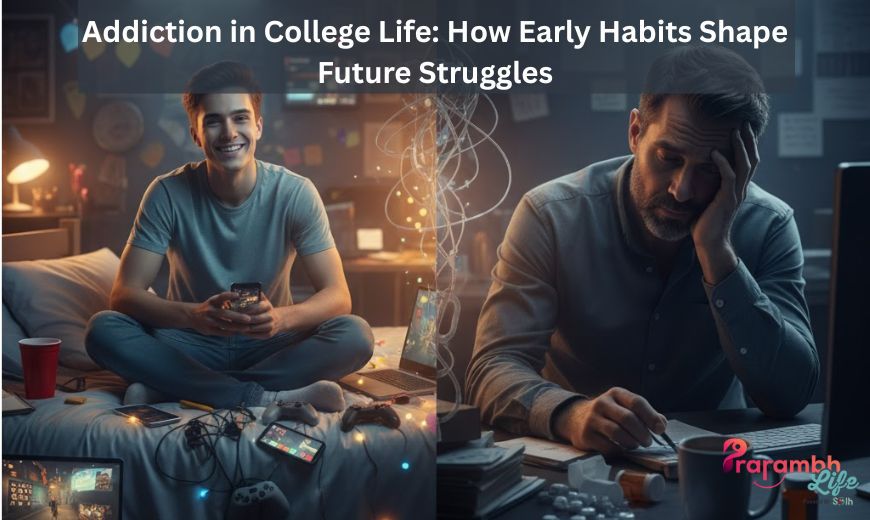
A college student pulling an all-nighter with coffee cups stacked high, promising themselves just one more game before bed, or scrolling through Instagram until the birds start chirping outside.
None of it feels alarming—it’s just college stuff, right? Freedom, fun, and pushing boundaries.
But here’s the catch: what starts as harmless habit often lays the tracks for long-term struggles. Whether it’s substance use, screen addiction, or even overworking, these early behaviors can quietly shape how we cope with stress for years to come.
So why does this happen?
And more importantly, how can students—and those who care for them—break the cycle before it spirals?
Why College Becomes a Breeding Ground for Addiction
College is a paradox—liberating and overwhelming at once.
Suddenly, you’re responsible for everything: your schedule, studies, meals, and mental balance. Freedom feels intoxicating, but without boundaries, it often comes at a price.
Add to that:
- Academic pressure that keeps students running on adrenaline.
- Social influence that normalizes drinking, smoking, or digital overuse.
- Emotional turbulence from being away from home, navigating identity, relationships, and expectations.
In this whirlwind, addiction doesn’t stem from recklessness—it stems from human vulnerability and the need to feel in control when everything else feels uncertain.
The Subtle Addictions Nobody Talks About
When we hear “addiction,” we often picture drugs or alcohol. But in today’s world, college addictions wear many masks:
- Substance use: Alcohol at every party, caffeine dependence, or recreational drugs.
- Behavioral patterns: Overstudying to exhaustion, binge-eating, compulsive scrolling, endless gaming, or Netflix marathons.
Individually, these may seem harmless. Who hasn’t pulled an all-nighter before an exam or lost hours to TikTok?
But the danger lies in repetition. Each “just one more time” strengthens the loop—and the brain learns to seek comfort from that pattern.
Why Early Habits in College Haunt Later Life
The science is simple yet sobering.
The brain craves dopamine, the “feel-good” chemical released when something pleasurable happens—like a social media like, a caffeine boost, or a drink after stress.
Over time, this creates a cycle:
Cue → Craving → Habit → Temporary Relief → Repeat.
Every repetition builds neural pathways that make the habit harder to resist.
What starts as a stress-relief ritual in college can become an automatic coping mechanism in adulthood—impacting work, relationships, and emotional health.
Spotting the Early Warning Signs
Most students dismiss their habits as normal, but subtle red flags can reveal deeper concerns:
- Restlessness or irritability when away from the behavior.
- Skipping meals, sleep, or classes to indulge in it.
- Making excuses or being secretive.
- Saying “I can stop anytime”—but never actually stopping.
Parents, teachers, and peers can play a vital role here. The earlier the signs are recognized, the easier recovery becomes.
Breaking Free: Why Support Matters More Than Willpower
Here’s the truth: addiction isn’t about weakness—it’s about wiring.
The brain learns patterns of escape. That’s why telling someone to “just quit” rarely works. What truly helps is structured, empathetic support that meets them where they are.
And this is exactly where Prarambh Life steps in.
The Prarambh Life 3-Month Program: Early Intervention
A lifeline for students beginning to notice unhealthy habits, this program isn’t about labeling—it’s about awareness and redirection.
It includes:
- AI-powered Stress Tracking (Streffie): Detects stress spikes before habits take control.
- My Diary: A safe online space to record feelings, cravings, and reflections.
- Grounding Exercises: Tools to calm the mind during stressful moments.
- Peer Support & Buddy Engagement: Because recovery feels lighter with community.
Perfect for those in the “just a phase” stage, it helps stop habits before they grow roots.
The Prarambh Life 6-Month Program: Deep Healing for Lasting Change
For students already feeling the impact—falling grades, strained relationships, or loss of control—the 6-month plan offers deeper, sustained care.
It focuses on:
- Relapse Prevention Modules: Spotting and defusing triggers early.
- Trauma-Informed Healing: Addressing emotional pain that fuels addictive loops.
- Rebuilding Self-Worth: Exercises and therapy to restore confidence.
- Boundary Building: Learning to say no—to self and others.
- Community Circles: Group workshops and sharing spaces for connection and accountability.
This isn’t just about quitting—it’s about rebuilding resilience that lasts into adulthood.
Practical Steps Students Can Try Today
Even without formal support, students can start small:
- Track your habits: Note when, why, and how often you engage in them.
- Pause before reacting: A deep breath can break automatic behavior loops.
- Replace habits: Choose healthier dopamine—exercise, art, nature, or real conversations.
- Talk about it: Opening up reduces shame and builds perspective.
A Note for Parents and Educators
The key is empathy, not enforcement. Students open up when they feel safe—not judged.
Ask, listen, and guide gently toward structured help.
Programs like Prarambh Life’s addiction recovery plans offer the right blend of technology, therapy, and trust—exactly what students need to find their balance again.
The Bigger Picture: Habits Don’t Define Destiny
Here’s what matters most:
College habits may shape our patterns—but they don’t define our future. With awareness and intervention, anyone can rewrite their story.
Prarambh Life bridges the gap—combining AI-backed insights with compassionate human guidance. Recovery doesn’t need to wait for “rock bottom.” It can begin quietly, early, and effectively.
Because ultimately, addiction isn’t about losing freedom—it’s about reclaiming it.
And every student deserves that chance.

